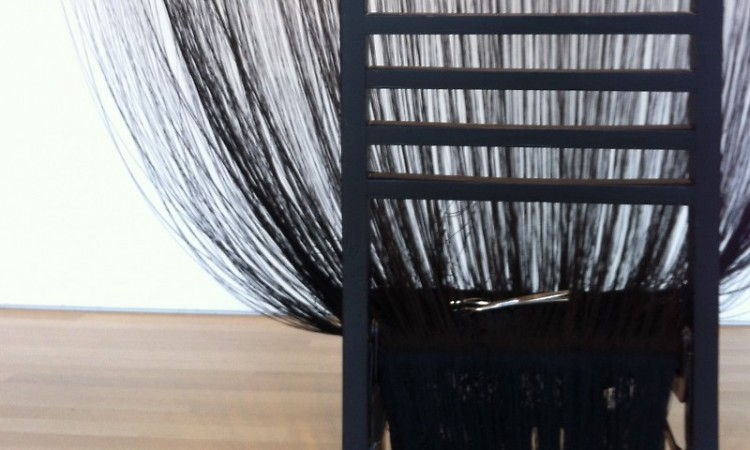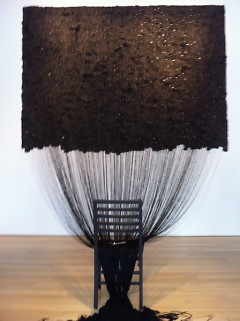Black chair, black squares of homemade paper tacked to the wall.
And in between, an army of black strings hang, connecting them before landing in a tangle on the floor.
What caught my eye in Andrew Hawkes' "It's not my fault," however, was the glimmering silver scissors on the chair, waiting to disconnect the two in one fell snip.
I couldn't stop thinking about those scissors. I had to ask the artist about that little detail resting on his creation, as if left there by accident at the end of installing the piece.
"Scissors elevate both the viewer’s and my own anxiety," says Hawkes. "At the core of the piece is the admission of how fleeting and ephemeral it is. When the show is over the string is cut, discarded. The paper [is] boxed up and the nails [are] put in a tupperware. All the obsessing over perfect I did [was] for nothing. At any time a viewer could simply pick up the scissors and destroy everything, which may seem a bit melodramatic, but it's true of all art. Sure we rope off things and have security guards standing watch, but really anyone could step over the rope and end the piece at anytime."
Hawkes' own struggle with anxiety was the inspiration for his piece.
"As an artist I wanted to create work about this period of time [in my life], this horrific few months of isolation and despair. I wanted to make something beautiful from this disgusting time. As an obsessive person I found myself drawn to paper, because I was able to lose myself in the ritual-like process of making. I was able to create hundreds of sheets in a few hours without realizing or thinking," explains Hawkes. "I chose string because to me it was a pointless and horrific obsessive material. Again the material allowed me to obsess mindlessly and fixate, offering an outlet for me to exert my nervous energy. String wants to tangle. It's in its nature and yet the entire time I struggle against that, much like I struggle against my own nature: my own anxiety and obsession with perfection."
Hawkes gushes about his experience at the GRAM, saying he's thankful for an opportunity of such magnitude and grateful that they even noticed him. He has found, as well, a satisfaction in the people seeing his work.
"It's been surreal standing by my work as thousands of people flood past. But truly it isn’t about numbers of people seeing my work. I’ve met so many people who have been through the same inner turmoil as myself and it feels really good to know I’m not alone in this," he says.
It's hard to imagine such a moving work coming from someone who doesn't even know if he can make it as an artist. Hawkes has that unique ability to take simple materials-paper and string- and transform them into something so meditative and other-worldly. There's a stage set, and we can start to piece together the players and the emotions. We know something is wrong here. And at the same time, there's a beauty present: in the rough edges of the handmade paper, the movement in the curve of the string, the silver tabs and silver scissors at either end. There's a struggle, there's a risk, and there's all this black... and we can't quite figure out the whole story we've come upon.
"Black represents both something beautiful and mysterious and also horrifying. Its interesting because paper is innately beautiful, yet to me black paper is somehow foreign and disturbing. Rarely do we ever encounter black paper. When we do, it is difficult to write on, difficult to read and somewhat baffling," says Hawkes.
Hawkes is very open about his own struggles with anxiety attacks and obsessive behaviors. Rather than trying to hide it, the artist has chosen to showcase it, to put it on display in front of all of us. Instead of letting it take over, the artist is able to harness what had most controlled him and create a contemplative scene that gives us a window into our own anxieties.
"The whole piece was a meditation for me," reveals Hawkes. "Through obsessing over seemingly nothing, I was able to find peace."
The Rapidian, a program of the 501(c)3 nonprofit Community Media Center, relies on the community’s support to help cover the cost of training reporters and publishing content.
We need your help.
If each of our readers and content creators who values this community platform help support its creation and maintenance, The Rapidian can continue to educate and facilitate a conversation around issues for years to come.
Please support The Rapidian and make a contribution today.


